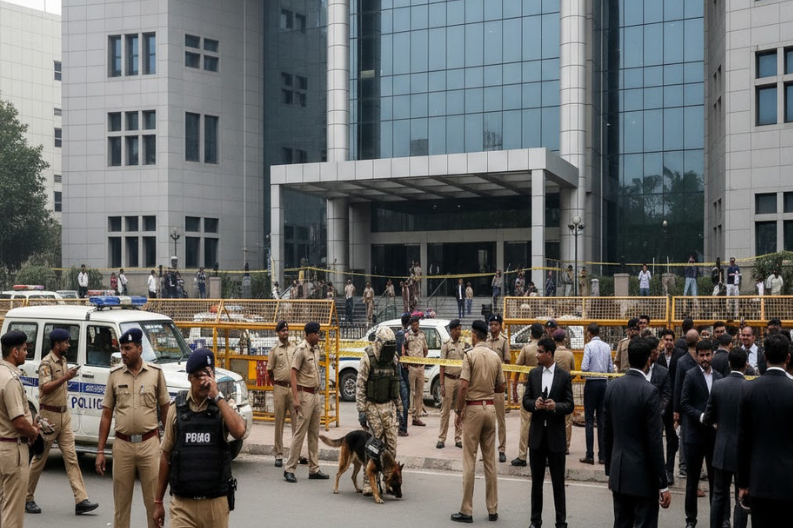On Tuesday morning, bomb threats made to court complexes created tension in Delhi after three major court buildings reported alarming email messages. The threats targeted the Dwarka, Saket, and Patiala House complexes, and officials quickly began full security checks. Although the situation caused fear, authorities moved fast to evacuate people safely and maintain order.
Soon after the email arrived around 9 AM, the police activated emergency teams. The message claimed that explosives were “strategically planted” inside all three locations. Because of this, bomb disposal squads and K9 units rushed to the sites. Although the checks took time, officers eventually confirmed that the warnings were false and found nothing dangerous.
Meanwhile, two CRPF schools also received bomb threats. One school is in Dwarka, and the other is in Prashant Vihar. Even though these threats came through a phone call rather than email, the police reacted immediately. They traced the caller to Rohini, but the house number given was fake. This rising trend of false threats is deeply concerning because it creates panic and disrupts daily life.
To reduce anxiety, the New Delhi Bar Association spoke directly to its members. Secretary Tarun Rana shared a circular asking advocates to stay calm. He explained that security at Patiala House Courts had been strengthened and that officers were working with full caution. His message reassured many lawyers who work daily in the complex.
Additionally, Vice-President Navneet Panwar reported that a complete sanitization exercise had taken place. This procedure helped ensure that courtrooms and corridors were safe for everyone. Such steps matter because Patiala House Courts handle high-profile cases from Punjab, Haryana, and Delhi.
In Saket Court, former Bar Association secretary Dhir Singh Kasana explained that proceedings stopped for nearly two hours. This break shows how much false alarms can impact the legal system. Even though the threats were hoaxes, they extended fear and slowed important judicial work.
Across Delhi, the response to these threats highlighted strong coordination between different agencies. Because the city often deals with sensitive cases, courts regularly practice security drills. These drills teach staff and lawyers how to respond during emergencies. They also encourage cooperation with police so that everyone knows what to do when a real danger appears.
While Delhi faced this situation, the importance of safe judicial spaces became clear for neighboring regions like Punjab and Haryana. Many people from these states depend on Delhi courts for appeals and hearings. Strong security not only protects court officials but also builds public trust in justice. People need to feel safe when fighting legal battles or seeking solutions for their problems.
Moreover, these hoax threats raise questions about why such incidents keep happening. Some experts believe that online anonymity makes it easy for people to create chaos. Others point out that large public buildings like courts and schools must constantly update their security systems. Because threats can appear through email, phone, or social media, stronger digital monitoring is becoming essential.
Although the threats turned out to be fake, they forced authorities to rethink safety measures. For example, more CCTV cameras may be added at entry points. Officials might also tighten the screening of bags and vehicles. In addition, cyber teams may look more closely at unusual email patterns so they can catch suspicious messages earlier.
Schools, courts, and hospitals are often soft targets for hoax calls. Therefore, public awareness is extremely important. When citizens understand how to recognize suspicious behavior, they can report issues faster. This early reporting helps police react before panic spreads.
Despite the disruption, Tuesday’s events showed that Delhi’s security system can handle pressure. The quick involvement of police teams, their firm communication with legal bodies, and their calm approach helped prevent unnecessary chaos. It proved that preparedness remains one of the strongest tools in such situations.
Parents of students in the CRPF schools also expressed relief after learning that the threats were false. Still, they asked authorities to review safety rules so that teachers and children always remain protected. Many parents now want clear emergency guidelines and regular safety drills.
In conclusion, although bomb threats made to court complexes caused fear across Delhi, the strong response from authorities prevented bigger problems. The incident reminds everyone that safety requires teamwork between police, legal workers, and the public. As Delhi continues improving its security, citizens must stay alert, cooperate with officials, and help protect important places in the city.



